You’ve probably heard whispers about black orchids, those enigmatic blooms that aren’t truly black but rather an intense purple-burgundy. While they’ll catch your eye with their dramatic appearance, it’s their cultivation requirements that often leave gardeners scratching their heads. These enchanting flowers, which can take up to seven years to bloom, have sparked legends from ancient Aztec temples to Victorian conservatories. Let’s explore what makes these elusive beauties so challenging to grow.
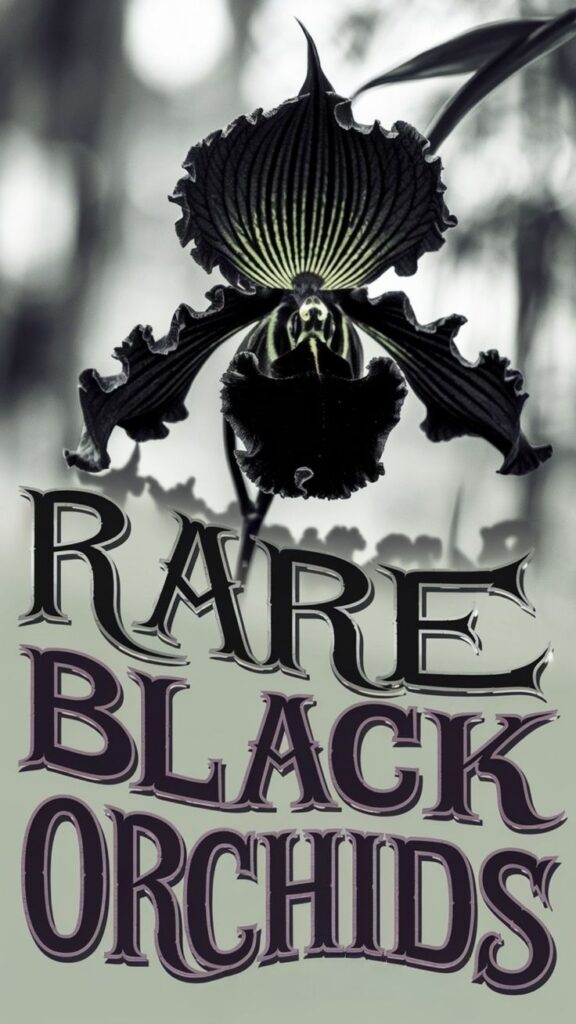
Contents
- 1 The Science Behind Dark Orchid Pigmentation
- 2 Historical Significance Across Ancient Cultures
- 3 Popular Varieties of Near-Black Orchids
- 3.1 Black Velvet Orchid (Maxillaria schunkeana)
- 3.2 Fredclarkeara After Dark
- 3.3 Monnierara Millennium Magic ‘Witchcraft’
- 3.4 Black Butterfly Orchid (Phalaenopsis Black Butterfly)
- 3.5 Dracula vampira
- 3.6 Cymbidium Kiwi Midnight
- 3.7 Paphiopedilum Black Jack
- 3.8 Vanda Black Magic
- 3.9 Cymbidium Cali Night
- 3.10 Paphiopedilum Wössner Black Wings
- 3.11 Phalaenopsis Kaoda Twinkle
- 3.12 Phalaenopsis Black Swan
- 3.13 Masdevallia rolfeana
- 3.14 Cymbidium canaliculatum
- 4 Essential Growing Conditions and Requirements
- 5 Myths and Legends From Around the World
- 6 Breeding Techniques for Darker Blooms
- 7 Collecting and Trading Dark Orchid Species
- 8 Common Cultivation Challenges and Solutions
- 9 Notable Black Orchid Collections Worldwide
- 10 Conservation Efforts and Future Preservation
The Science Behind Dark Orchid Pigmentation
While true black orchids don’t exist in nature, several species produce remarkably dark purple or burgundy blooms through a fascinating biochemical process. You’ll find these deep colors are created when anthocyanin pigments accumulate in high concentrations within the flower’s cells, often reaching levels of 150-200 mg per gram of tissue.
The darkest orchids, like Fredclarkeara After Dark and Catasetum Orchidglade, achieve their near-black appearance through a combination of concentrated purple pigments and specialized cell structures that trap and absorb light. These structures, called chromoplasts, cluster densely in the upper petal layers, creating an intense shadowing effect.
Historical Significance Across Ancient Cultures
Ancient Royal Court Symbolism
Throughout ancient civilizations, black orchids held a position of unmatched prestige within royal courts from Asia to South America. You’ll find records of these rare blooms adorning the headdresses of Aztec emperors and gracing Chinese imperial gardens as early as 500 BCE.
In royal courts, you’d have seen black orchids prominently displayed during ceremonies, where they symbolized absolute power and divine authority. Palace records show that servants maintained special growing chambers, and only designated royal gardeners could tend to these prized flowers.
If you’d visited Japan’s imperial court in 800 CE, you’d have noticed black orchids featured in official diplomatic gifts, representing the ultimate gesture of respect between nations.
Sacred Offerings and Rituals
Ancient priests and shamans regarded black orchids as essential elements in their most sacred ceremonies, incorporating these mysterious blooms into rituals spanning from Mediterranean temple offerings to Polynesian blessing ceremonies.
You’ll find evidence of black orchids in ceremonial vessels dating back to 600 BCE, where priests would place these rare flowers alongside precious oils and incense. In Egyptian temples, they’d position the blooms facing east during sunrise rituals.
The Mayans believed black orchids served as conduits between worlds, and you can still see their dried remnants in ancient burial chambers. They’d carefully preserve the flowers using a salt-drying technique that maintained the deep coloration for months.
Popular Varieties of Near-Black Orchids
Several stunning varieties of near-black orchids captivate collectors worldwide, though true black orchids don’t exist in nature.
Black Velvet Orchid (Maxillaria schunkeana)
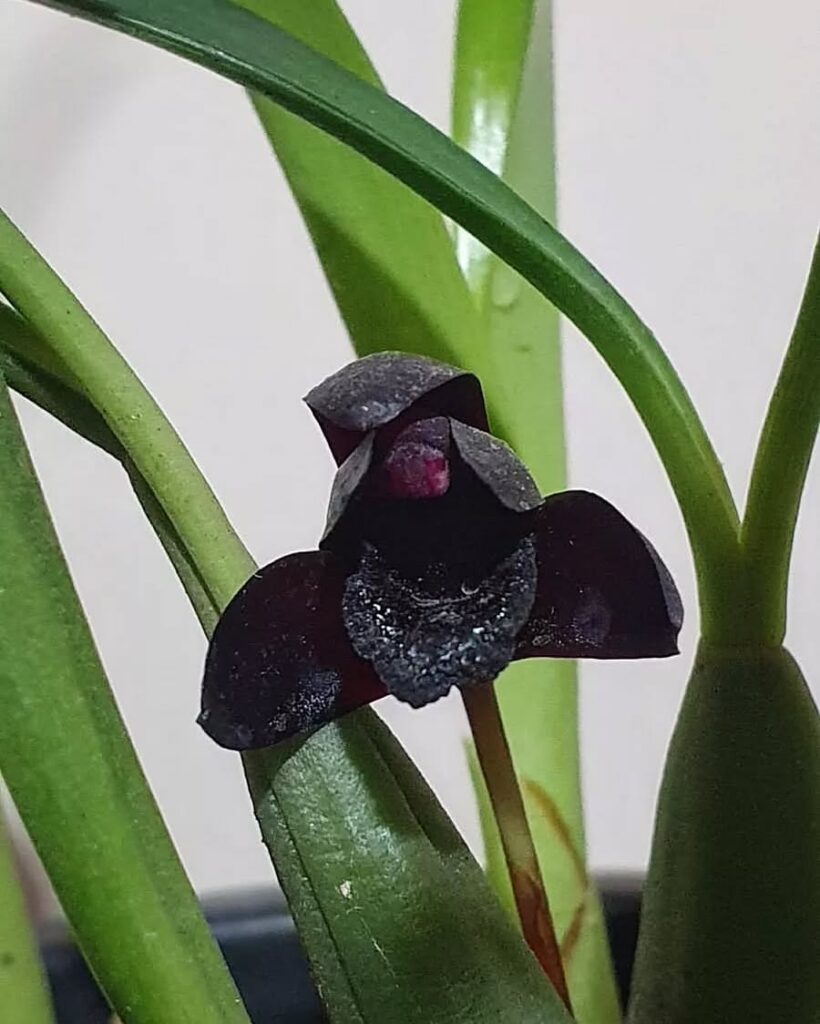
Known for its deep maroon flowers that appear almost black, this orchid is compact and thrives in shaded environments.
Fredclarkeara After Dark
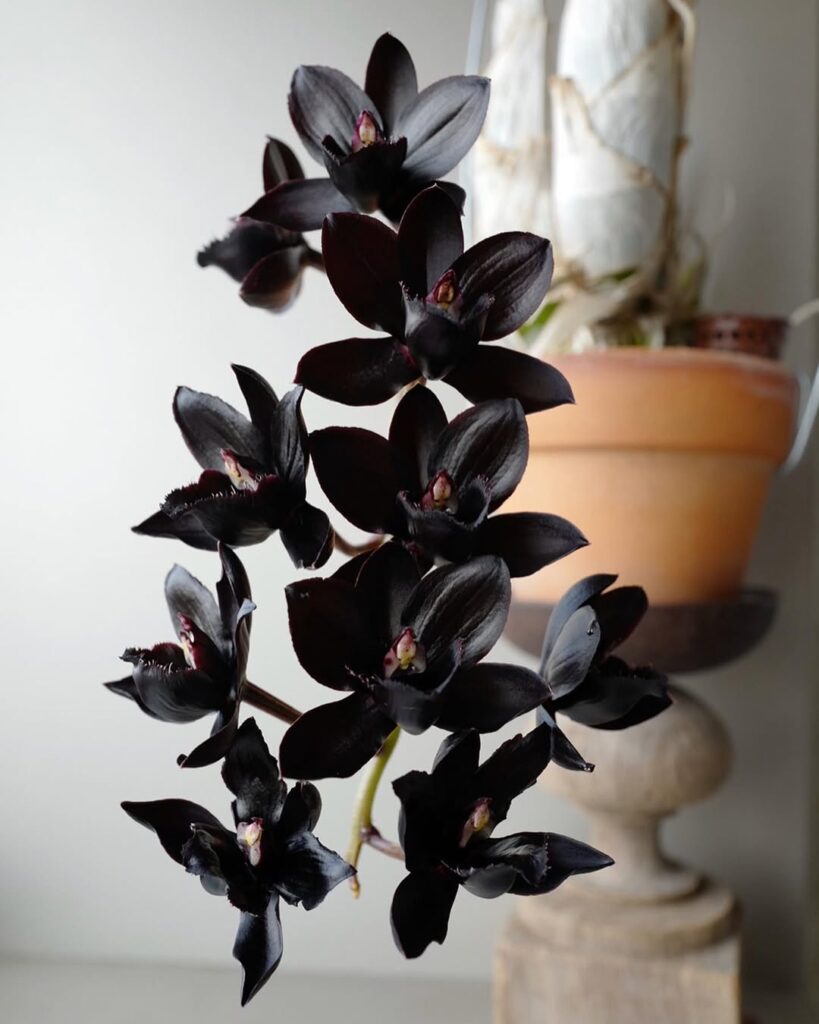
A prized hybrid with deep red-black flowers and a strong fragrance, often referred to as “SVO Black Pearl.”
Monnierara Millennium Magic ‘Witchcraft’
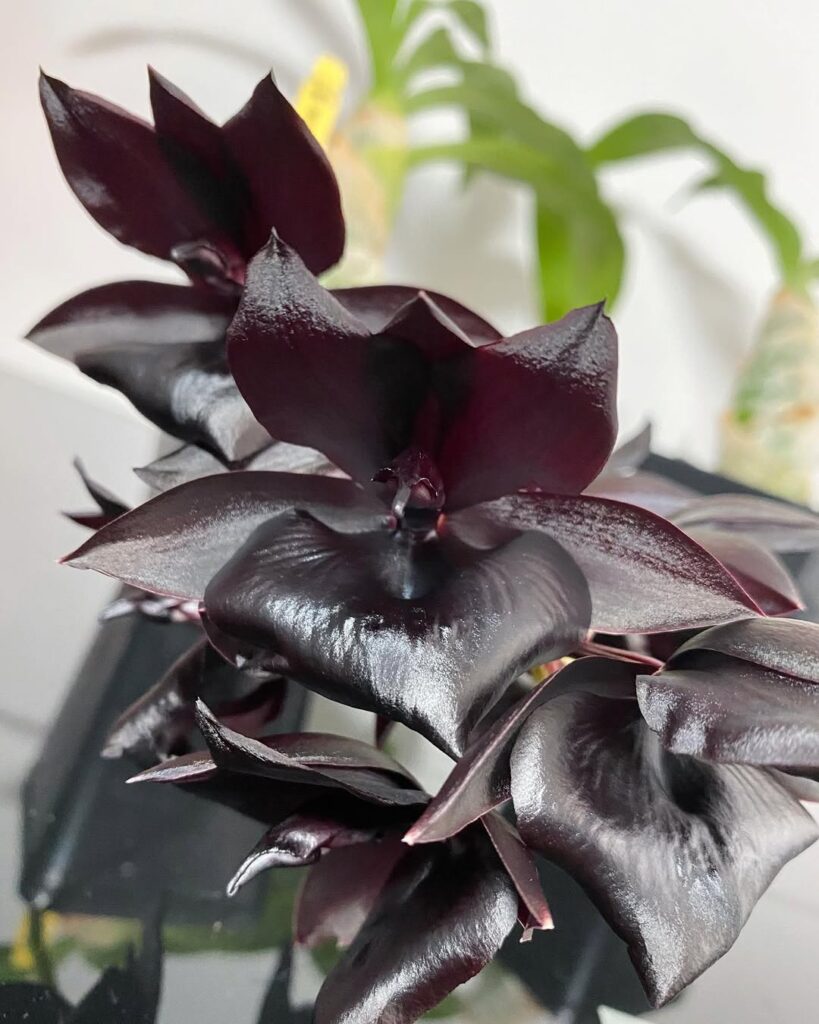
Awarded for its near-black blooms, this orchid is a standout in the world of dark orchids.
Black Butterfly Orchid (Phalaenopsis Black Butterfly)
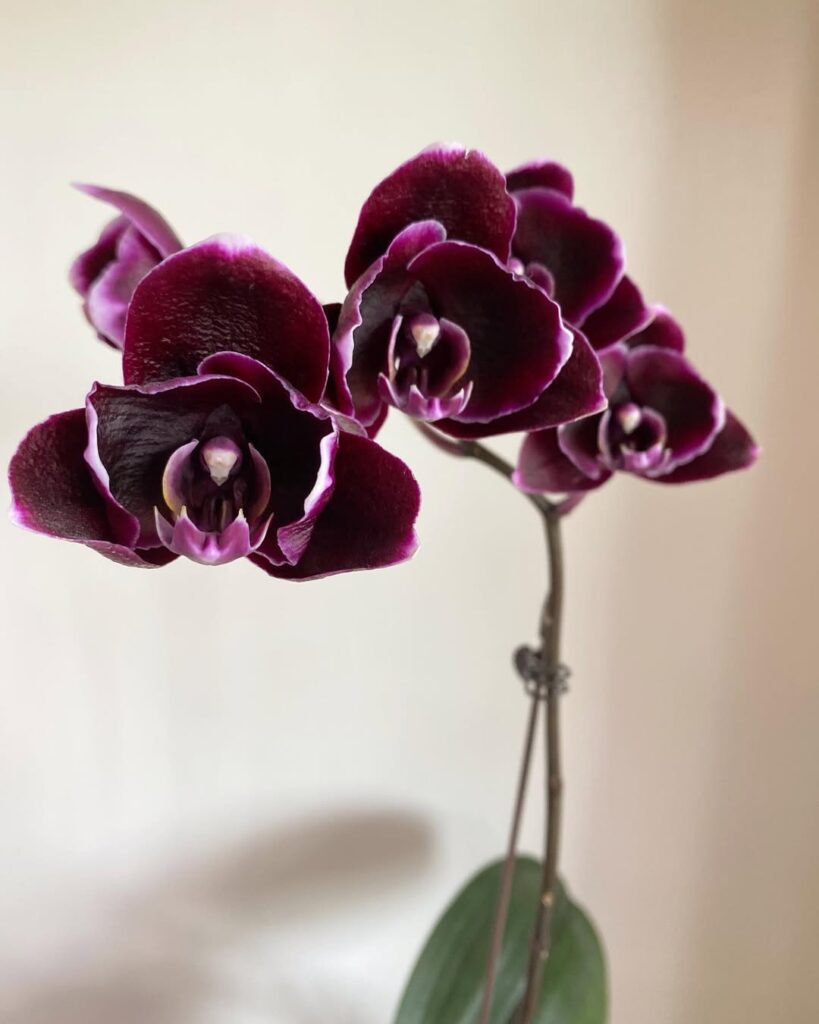
This hybrid features dark purple petals with light-colored spots resembling butterfly wings, creating a striking contrast.
Dracula vampira
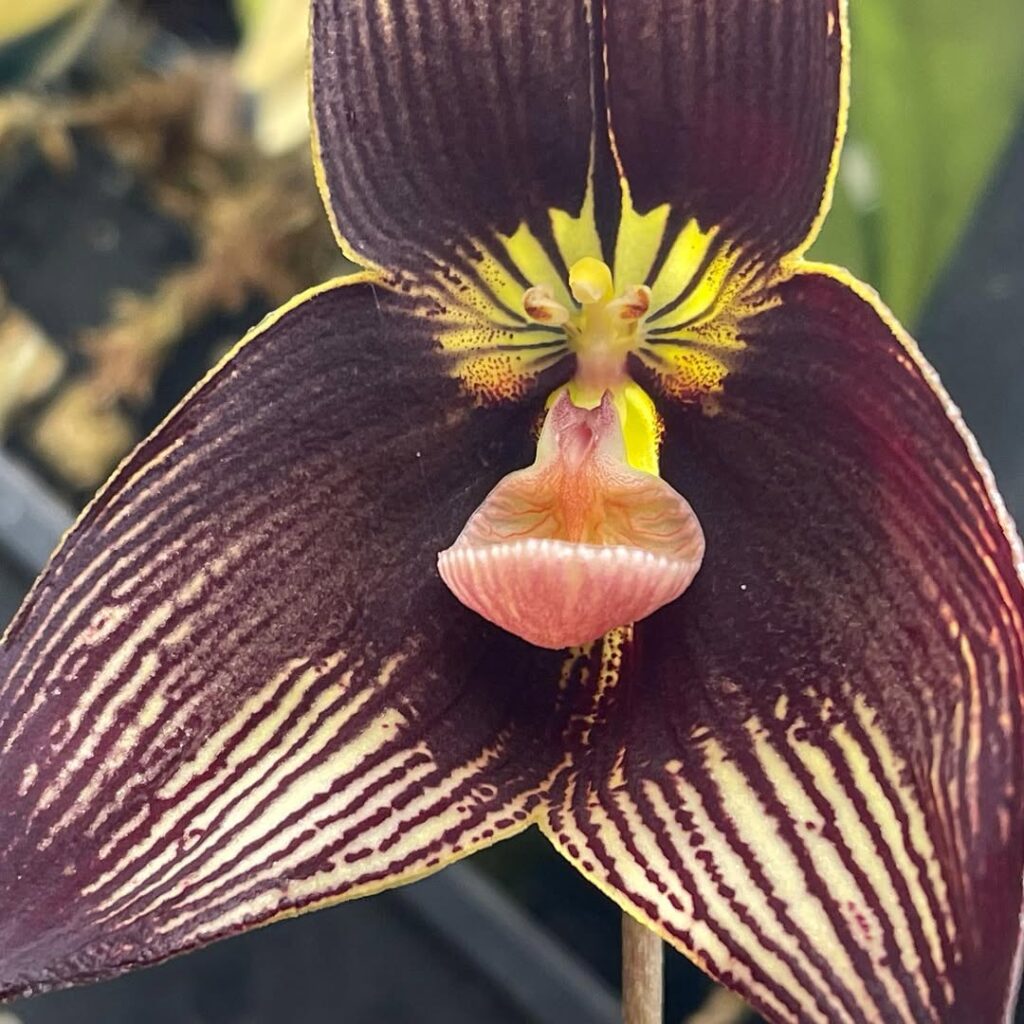
A fascinating orchid with bat-like flowers in dark hues, native to the cloud forests of Ecuador and Colombia.
Cymbidium Kiwi Midnight
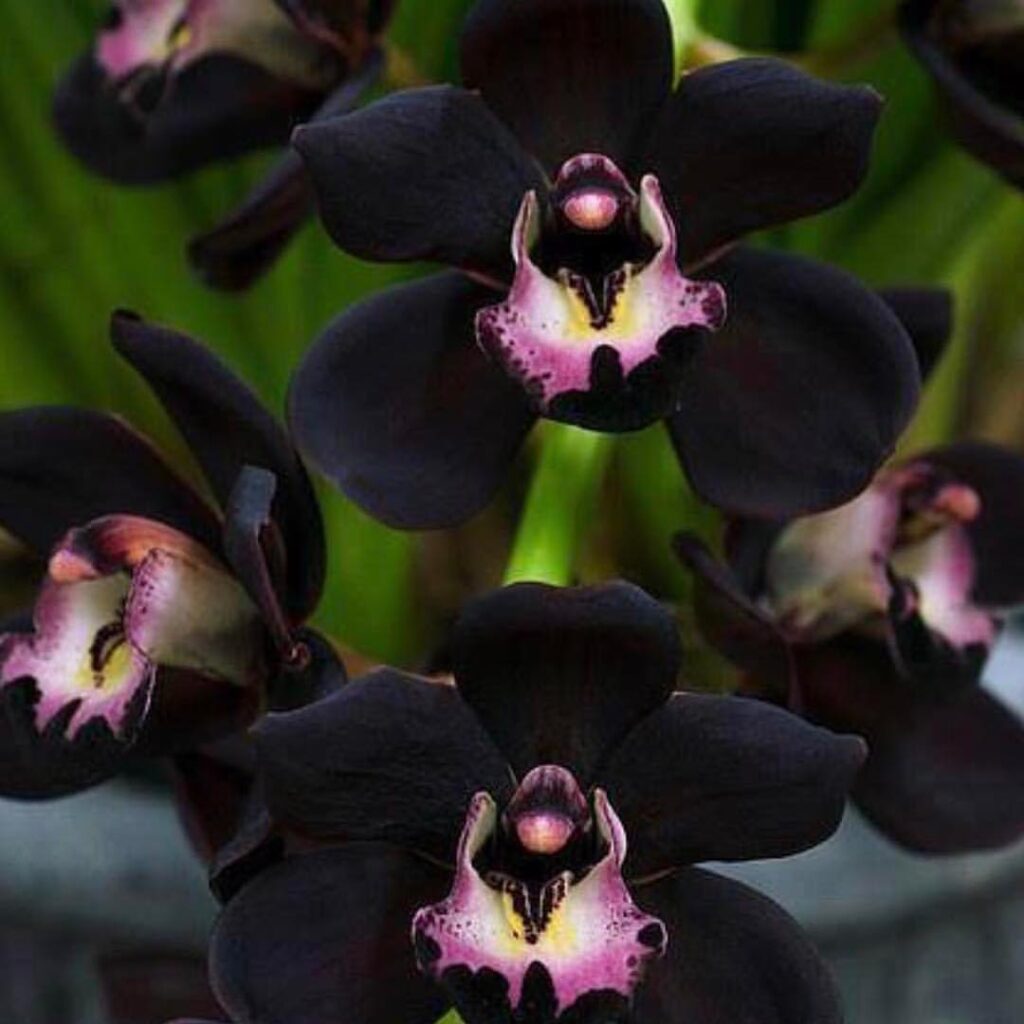
This Cymbidium hybrid boasts dark burgundy blooms that appear black under certain lighting conditions.
Paphiopedilum Black Jack
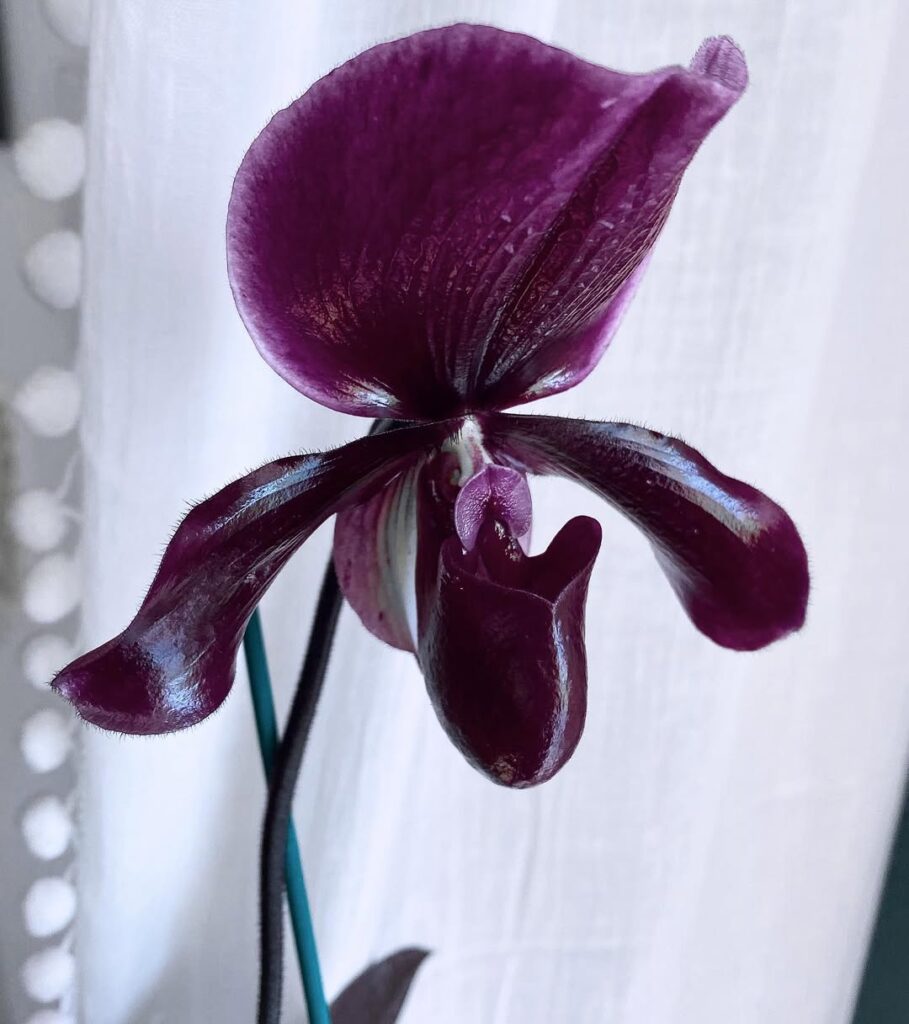
A slipper orchid with dark maroon petals and a unique pouch-like bloom.
Vanda Black Magic
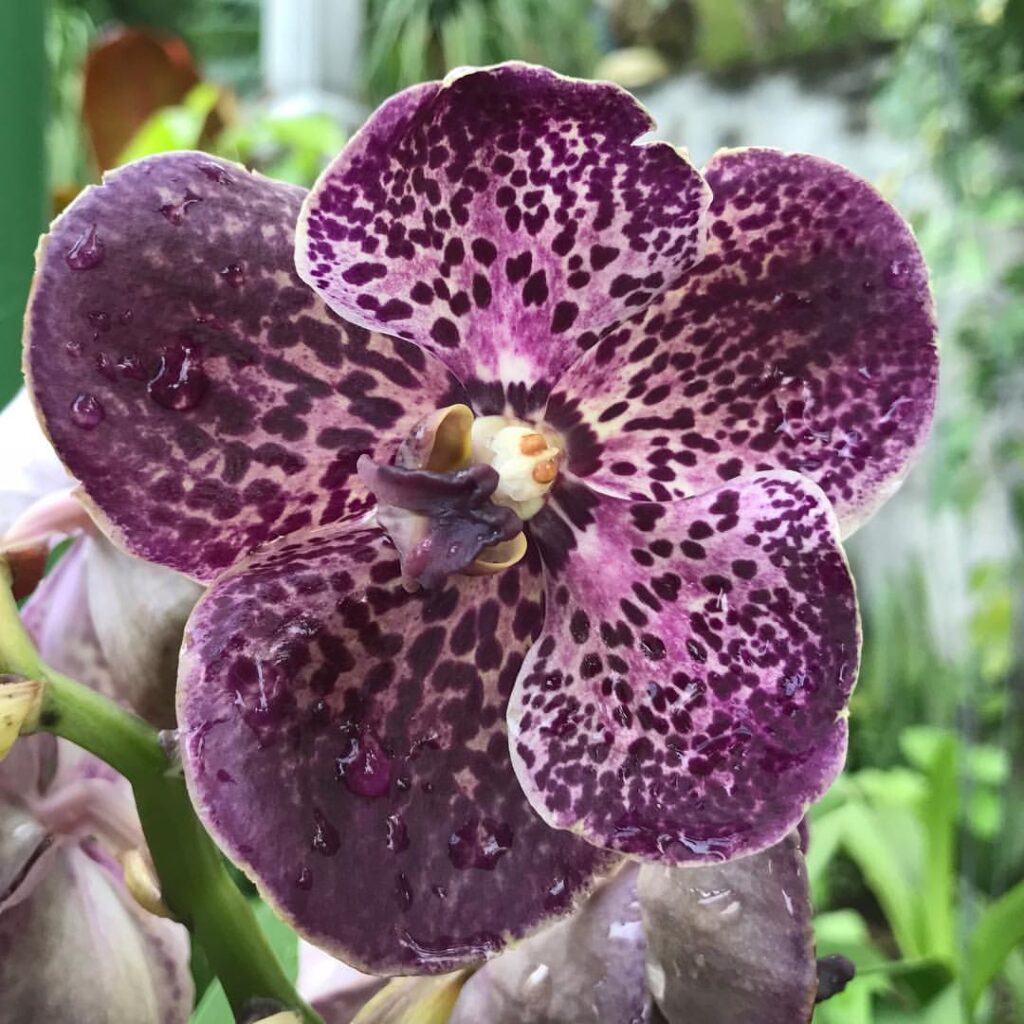
A stunning orchid with deep purple-black flowers and a glossy finish, perfect for dramatic displays.
Cymbidium Cali Night
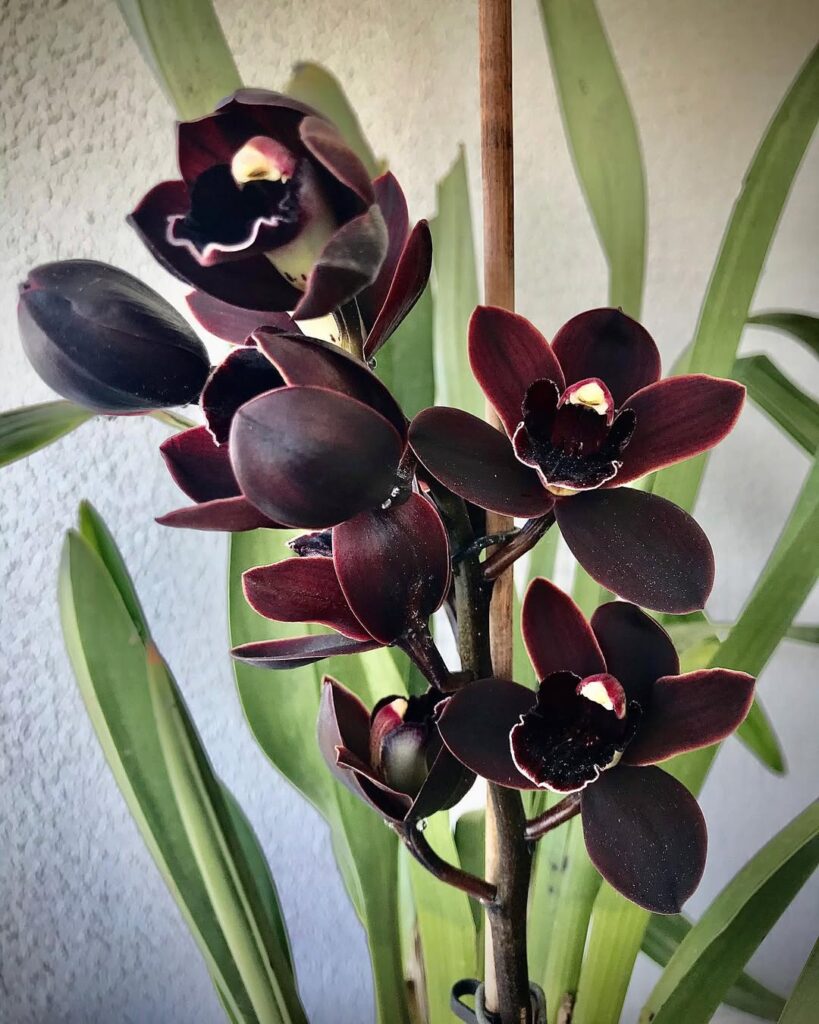
This hybrid produces dark, almost black flowers with a subtle sheen, adding elegance to arrangements.
Paphiopedilum Wössner Black Wings
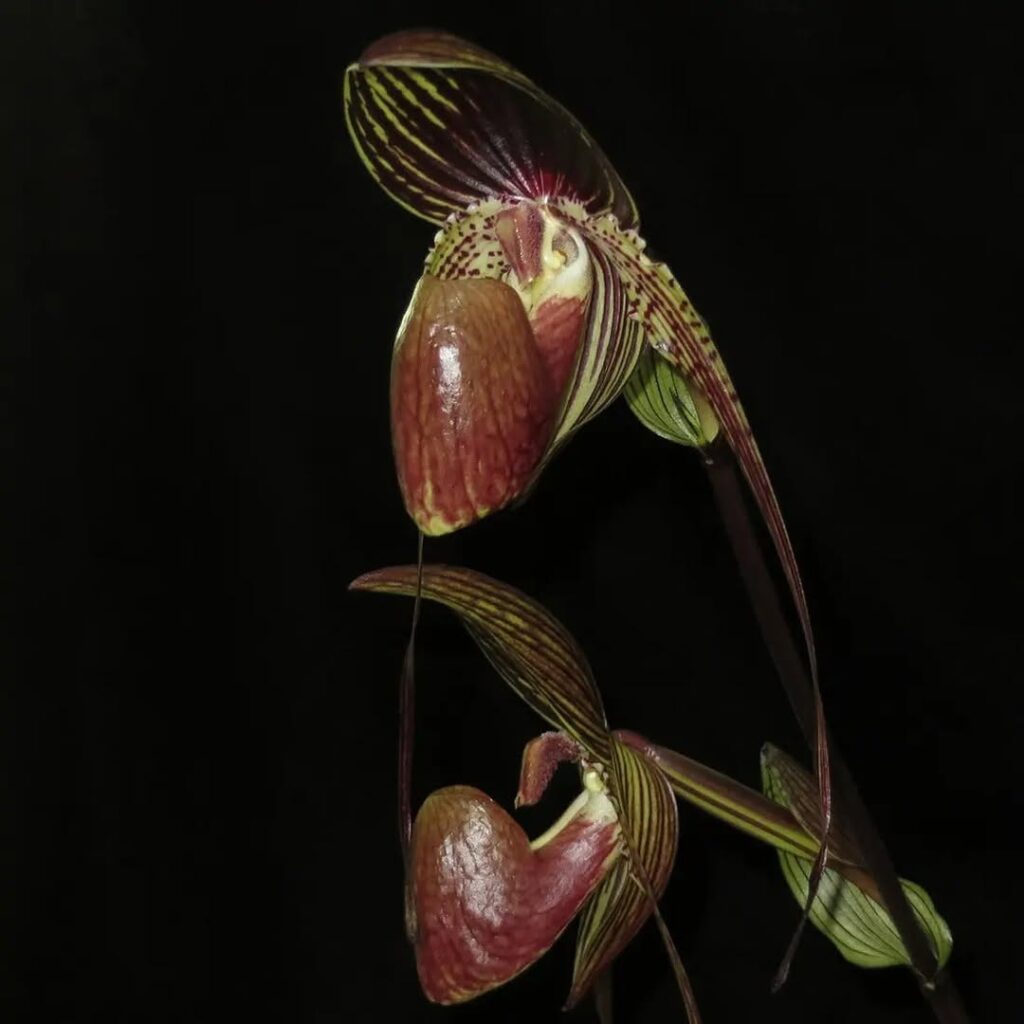
A rare slipper orchid with deep blackish-purple petals and a striking appearance.
Phalaenopsis Kaoda Twinkle

Known for its dark maroon blooms that resemble twinkling stars, this orchid is a favorite among collectors.
Phalaenopsis Black Swan
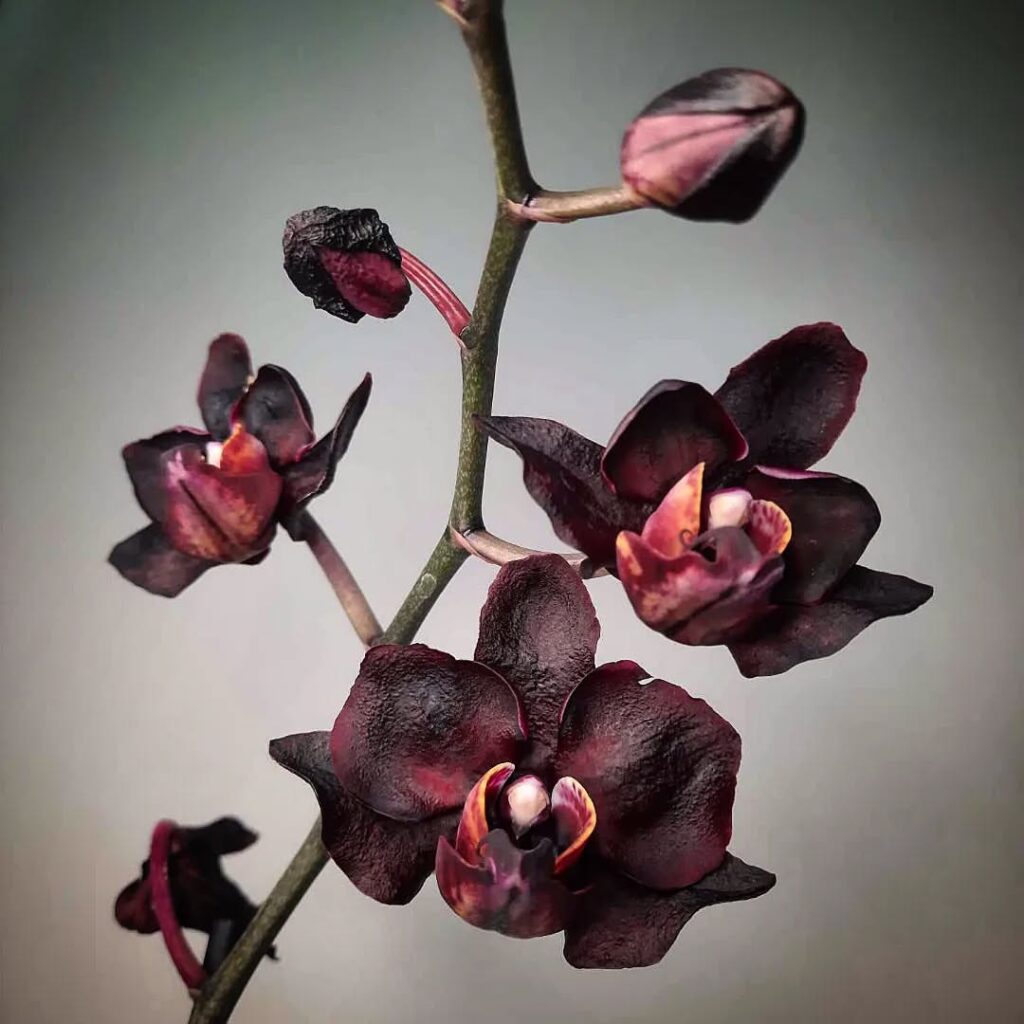
This orchid features deep purple-black flowers with a graceful, swan-like appearance.
Masdevallia rolfeana
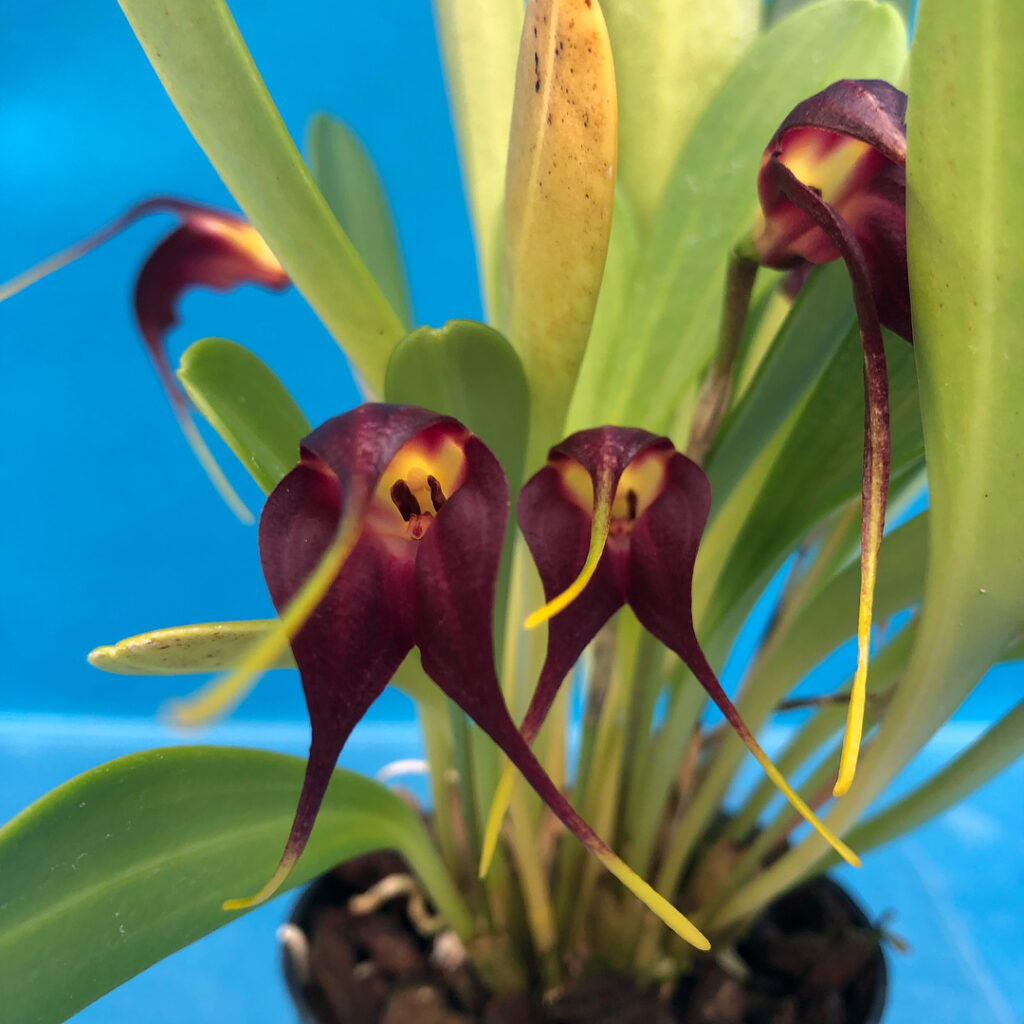
A natural black orchid with dark, velvety petals, admired for its rarity and beauty.
Cymbidium canaliculatum
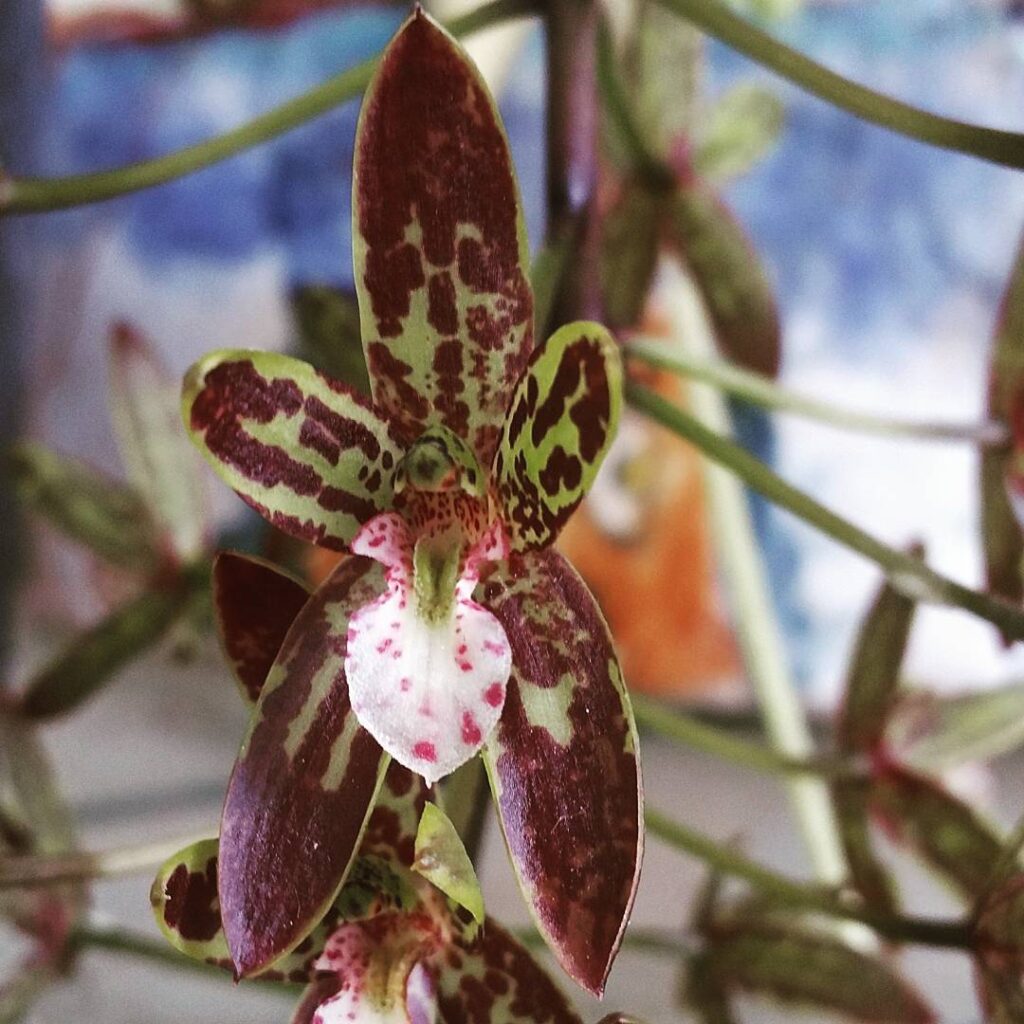
Also known as the Tiger Orchid, it produces star-shaped blackish flowers with crimson or purple markings.
Essential Growing Conditions and Requirements
To grow these dramatic near-black orchids successfully, you’ll need to maintain specific environmental conditions, including temperatures between 65-80°F and humidity levels of 50-70%. Your growing medium should consist of a well-draining mix of fir bark, perlite, and sphagnum moss, with the ratio adjusted based on your local climate and watering habits. While most black orchid varieties thrive in bright, indirect light, you’ll want to water them thoroughly when the top inch of medium feels dry, typically every 7-10 days during active growth.
Optimal Temperature and Humidity
Growing black orchids successfully requires maintaining precise temperature and humidity levels throughout the year. You’ll need to keep daytime temperatures between 75-85°F (24-29°C) and nighttime temperatures between 65-75°F (18-24°C). These temperature ranges mimic their natural tropical habitat.
For humidity, you’ll want to maintain levels between 60-80%. You can achieve this by using a humidity tray filled with pebbles and water, or by running a humidifier near your plants. During winter months, when indoor heating can dry the air, you’ll need to monitor levels more frequently.
Don’t let temperatures fluctuate dramatically, as this can shock your orchids and prevent blooming.
Soil and Potting Media
Beyond temperature and humidity control, proper potting media makes the difference between thriving black orchids and struggling ones. You’ll need a mix that’s 60% fir bark, 20% perlite, and 20% sphagnum moss for the best results.
Don’t use regular potting soil, as it’ll suffocate your orchid’s roots. Instead, you’ll want a coarse, well-draining mixture that allows air circulation. Break up any bark pieces larger than 1/2 inch to prevent water pooling.
Replace your potting media every 18-24 months, as it breaks down over time. When repotting, verify the new mix is pre-soaked for 24 hours to achieve proper moisture retention.
Light and Water Needs
Although black orchids have a mysterious reputation, their light and water requirements follow predictable patterns. You’ll want to provide bright, indirect light, keeping them away from harsh afternoon sun that could scorch their leaves. Morning light is ideal, especially from an east-facing window.
For watering, you’ll need to maintain consistent moisture without overdoing it. Water thoroughly when the top inch of potting media feels dry, typically every 7-10 days. During winter, reduce watering to every 2-3 weeks. It’s essential to guarantee proper drainage – you shouldn’t see standing water in the pot’s saucer for more than 30 minutes after watering.
Myths and Legends From Around the World
The mysterious black orchid has captivated imaginations for centuries, inspiring countless myths and legends across diverse cultures. You’ll find tales from ancient Greece, where black orchids were said to enhance fertility, while Indonesian folklore claims they grew from the ashes of dragons.
In Victorian England, you’d hear whispers of black orchids being used in love potions, while Native American tribes believed they could communicate with spirits through these rare blooms. Don’t be surprised to learn that in parts of Southeast Asia, people still believe these flowers only bloom at midnight during a new moon.
You can trace similar legends in South America, where black orchids symbolize both power and transformation.
Breeding Techniques for Darker Blooms
Moving from mythical tales to scientific reality, breeding darker orchid varieties requires careful selection and patience. You’ll need to start with naturally dark-pigmented species like Fredclarkeara After Dark or Catasetum Orchidglade.
To enhance the dark coloration, you’ll want to cross-pollinate flowers during early morning hours when pollen is fresh. After successful pollination, it’s essential to maintain temperatures between 65-75°F and humidity at 60-70%. The process typically takes 6-8 months for seed pods to mature.
Select seedlings showing the darkest pigmentation, and continue breeding these specimens. With each generation, you’ll achieve progressively deeper, richer colors approaching that elusive true black.
Collecting and Trading Dark Orchid Species
If you’re interested in collecting dark orchid species, you’ll need to understand their significant market values, which can range from $50 to over $5,000 per plant depending on rarity and bloom quality. Before acquiring these prized specimens, you’ll want to research necessary import permits and CITES documentation, especially for internationally sourced varieties. Reputable orchid traders typically maintain detailed provenance records and proper paperwork, so you should always request these materials before finalizing any purchase.
Market Values and Rarity
Rare dark orchid species command staggering prices in today’s collector’s market, with some specimens fetching upwards of $20,000 per plant. You’ll find naturally black orchids are among the most sought-after, particularly the Black Jade variety, which typically sells for $5,000 to $8,000 when mature.
If you’re looking to invest in these exotic beauties, you’ll need to verify their authenticity through certified dealers. True black orchids comprise less than 2% of known orchid species, and you’ll notice that many so-called “black” varieties are actually deep purple or burgundy in color.
Trading Guidelines and Permits
Trading these valuable specimens requires proper documentation and adherence to strict international regulations. You’ll need to obtain CITES permits, which protect endangered orchid species from illegal trafficking. Before purchasing any black orchid variety, verify the seller’s credentials and documentation.
When you’re ready to import or export these plants, you’ll need both origin and destination permits. Contact your local agricultural department for specific requirements, as they vary by country. Most permits take 30-60 days to process.
Common Cultivation Challenges and Solutions
While cultivating black orchids can be deeply rewarding, you’ll need to overcome several common challenges to achieve success. The most frequent issue you’ll face is root rot, which occurs when soil moisture exceeds 70%. To prevent this, make sure your potting medium has excellent drainage and never water more than once every 7-10 days.
Light exposure presents another hurdle, as black orchids require filtered sunlight at 2,000-3,000 foot-candles. You’ll want to place them 3 feet from an east-facing window, using a sheer curtain to diffuse direct rays. If leaves yellow, adjust lighting gradually until you achieve the best growth.
Notable Black Orchid Collections Worldwide
Three legendary black orchid collections stand as proof to successful cultivation techniques. You’ll find the world’s most extensive collection at Singapore’s National Orchid Garden, where they’ve cultivated over 200 black orchid specimens since 1995. The rare Coelogyne pandurata thrives in their climate-controlled conservatory.
At Hawaii’s Foster Botanical Garden, you’ll discover their prized collection of Black Jewel orchids, including the elusive Maxillaria schunkeana. Meanwhile, the Netherlands’ Leiden Botanical Garden maintains Europe’s finest assemblage, featuring 50+ specimens of black Cymbidium varieties that they’ve preserved through specialized propagation methods since the 1980s.
Conservation Efforts and Future Preservation
Because black orchids face increasing habitat loss, conservation programs have emerged globally to protect these rare specimens. You’ll find dedicated seed banks in Thailand, Ecuador, and Madagascar storing genetic material at -196°C, ensuring species survival.
If you’re interested in supporting conservation, you can join preservation networks that maintain databases of known populations. They’ll connect you with local chapters monitoring wild specimens every 3-6 months.
The future of black orchid preservation relies heavily on tissue culture labs, where you’ll see scientists producing clones of endangered varieties. These facilities typically achieve an 85% success rate in propagating rare species.
